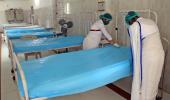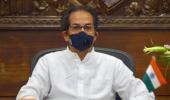Behind the state's success in containing coronavirus positive cases is one novel initiative -- Active Case Finding or ACF, which even Prime Minister Narendra Modi endorsed for the bigger states to follow.
The ACF campaign began in April with 16,000 basic health personnel, ASHA, anganwadi workers and auxiliary nurse midwives (ANM) out on foot trekking to most mountain valleys, snow-bound districts and remote passes of the state, reports Ashwani Sharma.

With the country entering phase 3 of the coronavirus-driven lockdown, Himachal Pradesh has done something right which is now being touted as a model for the rest of India to effectively combat the pandemic.
At a time when several big states are struggling to bring the figures down and control the virus’s spread, the tiny hill state with a population of a little over 70 lakhs finds itself safer, and slowly opening up to business and other activities.
Barring one person, who returned home from hotspot Delhi on April 29 and tested positive on Monday, Himachal Pradesh has just one active coronavirus case.
The total number of persons who tested positive since May 24 is 41, including three with foreign travel history and one 30-year old youth returning his village in Mandi district on April 29.
But there is a different success story that Himachal Pradesh is now boasting about after Prime Minister Narendra Modi praised its efforts. It’s about Active Case Finding (ACF) -- a comprehensive survey which many states have now started replicating following PM Modi’s acknowledgement.
The ACF campaign began in April with 16,000 basic health personnel, ASHA, anganwadi workers and auxiliary nurse midwives (ANM) out on foot trekking to most mountain valleys, snow-bound districts and remote passes of the state.
Their job was to reach out to every single house and hamlet and collect basic data on the travel history and health indicators of every family member and upload it online through Google Forms made available on their smart phones.
“The areas were mapped in advance. Google coordinates were generated for their benefit to make it easy to identify clusters and all scattered hamlets. We gave them basic training, and handed over face masks and sanitisers. Everyone was given a target to cover 30 houses, to fill up details, figures and health status of family members, indicating any member having influenza-like symptoms,” said Dr Jeeva Nand, chief medical officer, Mandi.
The district, second largest in the state after Kangra, had more than 10 lakh people to be covered, which the teams did in 10 to 11 days’ time .It took so long due to tough terrain like in Janjeli -- part of Chief Minister Jai Ram Thakur’s constituency Seraj -- Sandhol, Karsog, Paddar, Chauhar valley and Sarkaghat.
Recalls Anjana, 32, an ASHA worker, “Some of the houses were really hard to reach, marking a distance of five to six km on foot at top of the hill. It was a duty that I did without hesitation. I covered 20 to 25 houses in a day, and completed the backlog using some extra days.”
As Dr Jeeva Nand admits, ASHA workers also faced resistance from some families. “A few refused cooperate. We had no option but to take police help, and also send medical officers to convince those families. But such cases were isolated and people, generally, acted responsibly to help in the drive.”
The health workers even braved inclement weather, snow, as they went through forested valleys, crossed rivers/streams and climbed peaks without any rest for 10 to 12 hours a day to accomplish the task.
In Spiti, a high altitude snow-bound valley in Lahaul-Spiti, the team travelled 13 km on foot to survey the 10 families in the Mudh-Sagnum area.
“We had set up teams under 10 doctors, 14 ASHA workers, 10 health and anganwadi workers, beside health supervisors, to complete active case finding. The job was done in eight days to cover 61 villages, 2106 houses and 9428 persons,” says Dr Tenzin Norbu, block medical officer, Kaza.
The state government, through this drive, was able to generate a massive database of travel history of persons and creating an opportunity to ensure complete surveillance or testing, if needed for coronavirus.
“Nevertheless, we were able to find 10,043 cases of flu, ie, persons with influenza-like symptoms. Those requiring further examinations or tests were followed up. This way we covered 69.41 lakh people,” says Dr Nipun Jindal, mission director, National Health Mission and special secretary (health), who was the brain behind this campaign.
Asked how this idea was devised, Dr Jindal quotes the example of India‘s tracking of TB when a similar campaign was done.
This was also a stage when a lot of people who had a travel history were not willing to come out. There were also persons who had returned from hotspots in other states and UTs. Thus, the Active Case Finding drive proved a boon for the state to chase coronavirus when new cases started coming up.
The medical teams also collected 3200 samples, monitored each case and provided them with proper treatment.
Before the lockdown Himachal Pradesh had only three cases of coronavirus. All three had a history of foreign travel. Two, including a 69-year-old woman returning from Singapore, recovered and went home but a Tibetan, who went to a private hospital and did not inform the health department, died. Tests later confirmed him being a positive case.
The issue got complicated when Tablighi Jamaat returnees started testing positive. The number of cases increased to 40, of which 26 were Tablighi Jamaatis and their contacts.
The state government had to issue an ultimatum to all Tablighi Jamaat returnees to disclose their travel history and report to the police failing which they will be charged under law.
Chief Minister Jai Ram Thakur’s one big advantage was the state being small and manageable. The data received through Active Case Find helped the government identify each and every vulnerable person. Two COVID-19 positive cases in Hamirpur were traced only through the ACF process.
“Our goal was to chase coronavirus instead of coronavirus chasing the victims. That’s why Prime Minister Modi found ACF useful and recommended that other states follow the Himachal Pradesh model,“ Thakur says.
Dr Jindal, who is also is reportedly working on framing guidelines for the elders in the state who are highly vulnerable to coronavirus infection.










